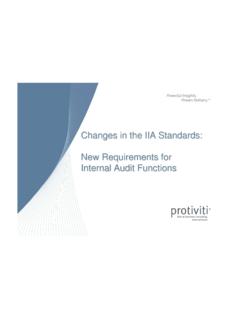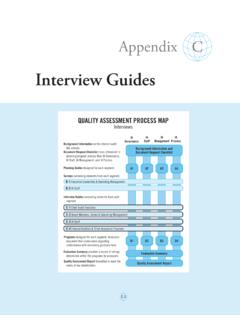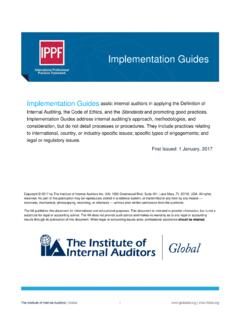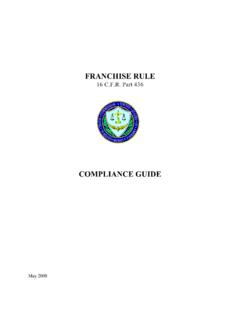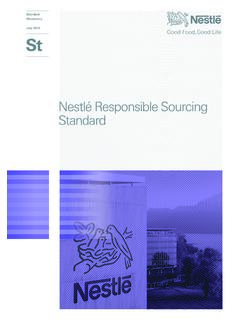Transcription of GUIDELINES FOR THE COMPLIANCE FUNCTION
1 GUIDELINES FOR THE COMPLIANCE FUNCTIONG uidelines for the COMPLIANCE function2 IIA NorgePREFACEA working group whose members work with COMPLIANCE in several different industries has developed the document GUIDELINES for the COMPLIANCE FUNCTION . The working group heads Network COMPLIANCE , a sub-faculty of the Association of Internal Auditors Norway (IIA Norge).IIA Norge would like to thank the following people for their help with the development of this guidance and incorporation of responses following the consultation round:Izabella Salicath, the Norwegian Export Credit AgencyJanne Britt Saltkjel, Multiconsult ASAM ette Knutsen, Assuranceforeningen SkuldGunnar Holm Ringen, PwCAnn Christin Flatland, NetsLars Kolbj rnsen, Norsk HydroChristina Str modden, DNBK athrine Stang Ottesen, Norges Bank (the Norwgian Central Bank)The goal of the working group has been to describe the purpose, responsibilities and duties of a COMPLIANCE functions, as well as the relevant assumptions and success factors, regardless of industry.
2 The principles in this guidance may also be useful for organizations without a discrete COMPLIANCE FUNCTION , but which have a similar FUNCTION with comparable target group for these GUIDELINES is organizations that would like to either establish a COMPLIANCE FUNCTION , or develop their existing COMPLIANCE FUNCTION from the Norwegian original by Katie Huchler, BDO ASPrefaceGuidelines for the COMPLIANCE functionCopyright IIA NorgeSeptember 2015 ISBN 978-82-92750-13-1 IIA Norge 3 CONTENTSP reface .. 21. Introduction purpose of this guidance .. 4 information about the COMPLIANCE FUNCTION .. 4 Internal control .. 5 Operational risk and COMPLIANCE risk .. 62. Organization and duties The Three Lines of Defence and segregation of duties .. 6 Management s commitment .. 8 Reporting and independence.
3 8 Organizational position and organization .. 9 Authority, information, resources and expertise .. 10 Remuneration .. 103. Methodology: COMPLIANCE FUNCTION s key activities Risk methodology .. 11 Governance framework .. 11 Tone at the top, communication and training .. 12 Background checks (Integrity Due diligence) .. 12 Registering deviations / reporting loss events .. 13 Whistleblowing .. 13 Monitoring and evaluation .. 13 Documentation .. 14 Reporting .. 14 About Network COMPLIANCE .. 15 CONTENTSG uidelines for the COMPLIANCE function4 IIA Norge1. INTRODUCTIONThe emergence of COMPLIANCE functions is relatively new, and it began in the USA shortly after the turn of the millennium. The establishment of COMPLIANCE functions was a direct consequence of several scandals, the Enron scandal in 2001 being the most significant.
4 These scandals led to improvements in the legal framework, as well as the recognition of weaknesses in regulatory risk management and internal control. Non-American organizations soon followed suit, and several Norwegian organizations have since established a COMPLIANCE FUNCTION . The word COMPLIANCE can be loosely translated into Norwegian using the words samsvar or etterlevelse , which both imply conformity or COMPLIANCE with laws, rules and GUIDELINES . There is however no Norwegian term for the COMPLIANCE FUNCTION , and for many the role and duties of the COMPLIANCE FUNCTION are still unclear. There is therefore a need to clarify both of these elements, as well as the criteria that need to be met to allow the COMPLIANCE FUNCTION to fulfil its duties in a satisfactory The purpose of this guidanceThe need to establish a COMPLIANCE FUNCTION will depend on, amongst other things, the industry and the organization, although typically the drivers are regulatory requirements and/or exposure to the risk of violating laws and regulations.
5 Examples of this can be corruption risk or reputational risk. For some industries/organizations, it is a legal requirement to have a COMPLIANCE this guidance we have tried to describe best practice for COMPLIANCE functions regardless of industry, regulation and size. It does not cover the legal requirements to which COMPLIANCE functions may be subject, rather it introduces the basic principles of the FUNCTION . Individual adaptations will naturally depend on each organization s nature, size and risk industry specific GUIDELINES have been developed internationally to describe the elements of an effective COMPLIANCE FUNCTION , depending on the specific regulatory requirements. Common components from these GUIDELINES , in combination with practice in Norwegian industry, form the basis of this document uses the term COMPLIANCE FUNCTION .
6 This does not mean that there is necessarily one person who holds this position. Rather, COMPLIANCE work represents a specialized approach to identifying risk, as well as designing and implementing internal controls, which together reduce the risk of failure to comply with relevant laws and this document, we have sought to provide some clarification regarding the organization of a COMPLIANCE FUNCTION , as well as the distribution of roles and responsibilities between the different functions of an organization, such as the legal department, internal audit, risk management and for the COMPLIANCE functionIIA Norge General information about the COMPLIANCE FUNCTION COMPLIANCE refers to conformity with both external1 and internal2 laws and regulations. COMPLIANCE is a line management responsibility reporting ultimately to executive management (see Section on the three lines of defence).
7 The COMPLIANCE FUNCTION should, nevertheless, contribute to helping line management develop and implement an effective system of internal control in order to manage the risk of violating external and internal laws and regulations ( COMPLIANCE risk).The COMPLIANCE FUNCTION should have a preventive, advisory and supervisory role, with particular emphasis on: Facilitating the effective identification of risk of violation of relevant external requirements, such as COMPLIANCE with laws and regulations, as well as providing advice on risk reduction measures. Developing and facilitating the implementation of internal controls that will provide the organization with protection from COMPLIANCE risk. Monitoring and reporting on the effectiveness of control measures. Providing the business with advice about acceptable behaviour and practices in relation to the interpretation of external and internal rules.
8 Monitoring relevant regulatory developments within the COMPLIANCE FUNCTION s areas of responsibility. Ensuring awareness and performing the tasks above, the COMPLIANCE FUNCTION should cooperate with other subject matter experts/departments, such as legal, risk, human resources, quality management, internal control and internal Internal controlThe term internal control encompasses the processes and measures that are intended to reduce the risk of events that could threaten the organization s achievement of its objectives. This is, among other things, to ensure effective and efficient operations, reliable reporting and COMPLIANCE with external and internal regulations, cf. The Committee of Sponsoring Organizations of the Treadway Commission (COSO).Internal control therefore implies more than the pure hard control measures, such as authorizations, reconciliation procedures, quality assurance, but also the soft controls related to attitudes, values, culture and for the COMPLIANCE function1 By external laws and regulations is meant first and foremost laws, statutory instruments, and decisions made by public authorities based on statutory powers.
9 Some people include in this definition also industry norms and standards as well as contractual commitments in sales or supplier By internal laws and regulations is often meant policy GUIDELINES and instructions from the Board and executive IIA Operational risk and COMPLIANCE risk Operational risk is the risk of failure of processes related to business operations. COMPLIANCE risk is the risk that the company s operations lead to violation(s) of regulatory requirements (including statutory regulations). COMPLIANCE risk is therefore considered to be an operational risk. For example, the possibility of failure in IT systems poses an operational risk, but if this also means that the business cannot fulfil a legal requirement that is supported by the IT system, the system s failure can as also be considered to be a COMPLIANCE individual organization must be aware of establishing the structure which is best suited to the achievement of effective risk management.
10 This assessment must be documented. Some organizations have divided the structure of the second-line s monitoring of operational risk and COMPLIANCE risk while other businesses have placed the functions together in the same department. Regardless of their position, there should be a close dialogue and coordination of the work between the various functions. The organizational position and segregation of duties from other control functions are essential prerequisites for providing the COMPLIANCE FUNCTION with authority and the ability to exercise its role. Chapter 2 describes in further detail the most important aspects related to organization and duties which must be taken into account when establishing a COMPLIANCE ORGANIZATION AND The Three Lines of Defence and segregation of dutiesAs a basis for the effective use of resources, as well as to avoid the risk of unsatisfactory monitoring of controls or of duplication of risk management functions and activities, it is important to define clearly the roles and responsibilities of the various organizational functions.

